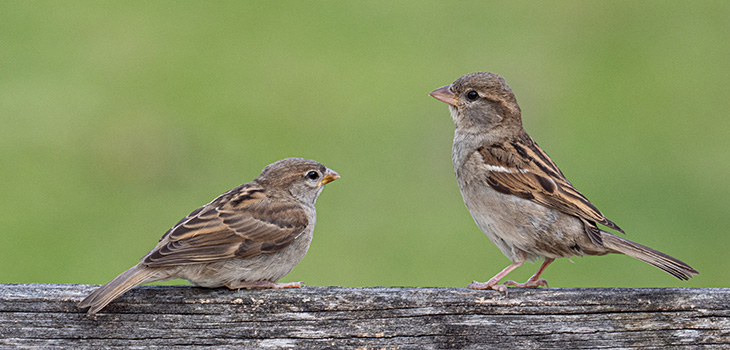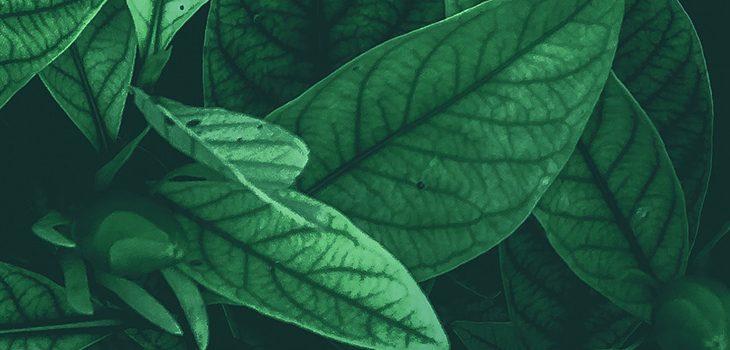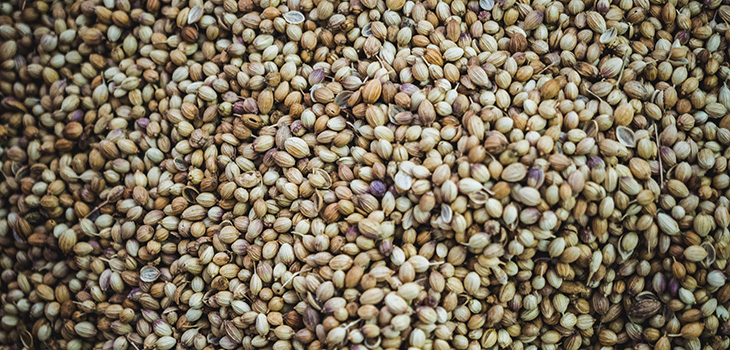Written by Michael Miller, current 2022-23 master’s student
It’s official! I have finally begun my graduate school journey to become an environmental educator through Goshen College’s Master of Arts in Environmental Education program at Merry Lea.
This new adventure begins 11 years after graduating from Goshen College with a B.A. in Environmental Science and starting a family with my wife Jennifer of 19 years. Over the next year, I will be living and studying at Merry Lea, a 1,198-acre nature preserve, with the ultimate goal of teaching environmental science at the high school level.
So how did I get to this point in the journey and what made me decide to become an educator?
After finishing coursework the fall of 2011, I began working as a restoration specialist for Blue Heron Ministries: a small native lands restoration company located in Angola, Ind. where I interned the previous summer.
At Blue Heron Ministries, I applied knowledge that I acquired over the previous 4 years and began to fall in love with the intricacies of prairie, savanna and wetland ecosystems.
However, in 2014 my wife was offered her dream job in the Washington, D.C. metro area, so we relocated. Not long after the move, I accepted a position as a conservation specialist with the Prince William Soil & Water Conservation District in Manassas, Va. where I helped the citizens of Prince County resolve non-point source pollution through best management practices in rural and suburban settings.
Non-point source pollution occurs when runoff from rain and snowmelt carries pollutants from a wide area into waterways: rivers, streams, wetlands, groundwater or lakes.
Both of these jobs had a fair amount of educational components with a wide range of age groups. During these community events that involved environmental education, I realized that not only do I have a love for implementing environmental science, but I have a passion for teaching and sharing my knowledge.
After some family discussions, we moved back to the midwest so I can transition into becoming an environmental educator! And thanks to accommodating telework policies resulting from the pandemic, my wife can continue her career as I begin this master’s program along with four other individuals for the 2022-23 school year.
Getting Reacquainted with an Old Friend
Before living in Virginia, I spent the bulk of my time in prairies, oak-hickory savannas, and wetlands (especially fens) in Michigan, Indiana and Ohio, even when I wasn’t actively restoring or maintaining them.
So when I learned that each grad student must choose an ecosystem to observe over several weeks for our Natural History of the Southern Great Lakes summer course, I naturally chose Luckey’s Landing: a location where a savanna and fen meet a wooded area along High Lake’s shores.
Within seconds of walking into this unique area that is full of life, I knew I made the right choice as it felt like I was meeting with an old friend.
With this familiar friend, my memory is continually refreshed of species that I learned from previous experiences; but I also get to dive into a more intense relationship and learning experience with this ecosystem and the plethora of species that call this place home. I hope to encounter the Massasauga Rattlesnake during my observations.
But what makes this site so interesting? Luckey’s Landing is dominated by a mixture of mainly warm-season grasses, sedges and forbs that are in both a grassland and oak/hickory savanna setting. This habitat formed due to the amount of sunlight available to the plant community and the historic fluctuation of the water table. Over time, this allowed both wetland and upland plants to grow in the same area along with the species that depend on them to survive.
Species Spotlights at Luckey’s Landing
Common Yellowthroat (Geothlypis trichas)
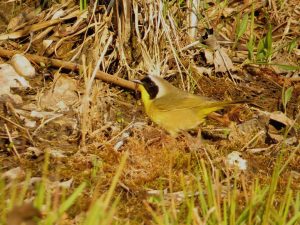 The common yellowthroat utilizes the wetland habitat at Luckey’s Landing in the dense growth where the fen meets the adjacent woodland. This habitat is required for all aspects of the bird’s life cycle. Their diet consists of mainly insects found in most wetland ecosystems, such as dragonflies, mayflies and grasshoppers, which are often foraged from plant surfaces. The common yellowthroat will also occasionally feed on seeds.
The common yellowthroat utilizes the wetland habitat at Luckey’s Landing in the dense growth where the fen meets the adjacent woodland. This habitat is required for all aspects of the bird’s life cycle. Their diet consists of mainly insects found in most wetland ecosystems, such as dragonflies, mayflies and grasshoppers, which are often foraged from plant surfaces. The common yellowthroat will also occasionally feed on seeds.
Photo by Marty Stoner | Merry Lea volunteer
Yellow-throated Vireo (Vireo flavifrons)
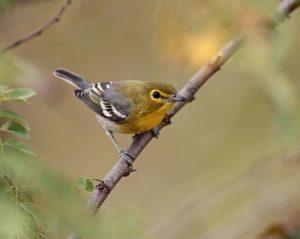 The yellow-throated vireo prefers to breed in tall deciduous trees, like oaks and maples, that grow near the edges of lakes or streams, making Luckey’s Landing the perfect spot to see these birds in the spring and summer. They migrate south to overwinter in tropical lowlands and foothills. The yellow-throated vireo feeds mainly on insects but will occasionally consume berries in the fall: in fact, up to a third of its diet may consist of caterpillars. This makes sense due to the abundance of butterflies and moths I have observed in this ecosystem. The yellow-throated vireo will avoid dense undergrowth, which makes the oak/hickory savanna at Luckey’s Landing – with its tall oaks and hickories and its open understory – a recommended location for observing this species.
The yellow-throated vireo prefers to breed in tall deciduous trees, like oaks and maples, that grow near the edges of lakes or streams, making Luckey’s Landing the perfect spot to see these birds in the spring and summer. They migrate south to overwinter in tropical lowlands and foothills. The yellow-throated vireo feeds mainly on insects but will occasionally consume berries in the fall: in fact, up to a third of its diet may consist of caterpillars. This makes sense due to the abundance of butterflies and moths I have observed in this ecosystem. The yellow-throated vireo will avoid dense undergrowth, which makes the oak/hickory savanna at Luckey’s Landing – with its tall oaks and hickories and its open understory – a recommended location for observing this species.
Photo from Audubon | https://www,audubon.org/field-guide/bird/yellow-throated-vireo
Pearly Crescentspot (Phyciodes tharos)
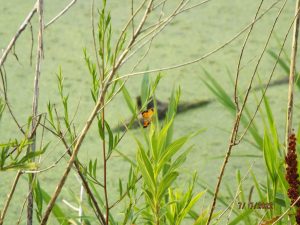 The pearly crescentspot is a common butterfly that occurs throughout most of Indiana and the United States. It is a fast flier that will frequently chase other nearby butterflies. It will visit both native flowers and cultivars, however it prefers to lay its eggs on asters and other compositely flowering plants. Pearly crescentspots can be found at Luckey’s Landing from early April or May to October. These butterflies are seen at this location because they prefer to mate near the margins of lakes, streams and rivers.
The pearly crescentspot is a common butterfly that occurs throughout most of Indiana and the United States. It is a fast flier that will frequently chase other nearby butterflies. It will visit both native flowers and cultivars, however it prefers to lay its eggs on asters and other compositely flowering plants. Pearly crescentspots can be found at Luckey’s Landing from early April or May to October. These butterflies are seen at this location because they prefer to mate near the margins of lakes, streams and rivers.
Photo by Mike Miller | Merry Lea graduate student
Common Green Darner (Anax junius)
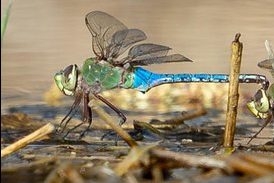 While sitting and observing at Luckey’s Landing, I cannot help but notice the abundance of dragonfly species. Out of these species, the green darner is one of the most common dragonflies in North America. All dragonflies begin their life as naiads (or nymphs) in bodies of water. Both adults and juveniles eat many many other species of flying insects such as gnats, flies and mosquitoes. Many of these dragonflies will migrate south from July through October; however, some individuals do not migrate and remain in the area for their entire lives.
While sitting and observing at Luckey’s Landing, I cannot help but notice the abundance of dragonfly species. Out of these species, the green darner is one of the most common dragonflies in North America. All dragonflies begin their life as naiads (or nymphs) in bodies of water. Both adults and juveniles eat many many other species of flying insects such as gnats, flies and mosquitoes. Many of these dragonflies will migrate south from July through October; however, some individuals do not migrate and remain in the area for their entire lives.
Photo from University of Minnesota | https://entomology.umn.edu/common-green-darner
Creative Space
Have you ever just stopped and listened to the symphony of nature surrounding you?
Have you ever just taken the time to find a quiet nook where the sounds of man are dulled and the sounds of nature intensified?
A place where you can hear the harmony between the birds’ songs like that of the warblers and the wrens
A place filled with the buzzing of the bees and the stridulation of the crickets?
A place where the peeping of the frogs is deafening and calming at the same time?
When you find this place, watch the grass and flowers dance in the breeze. Close your eyes and commit the song to memory, for the next time you find it, it may be forever changed because sometimes this is the way of man.

